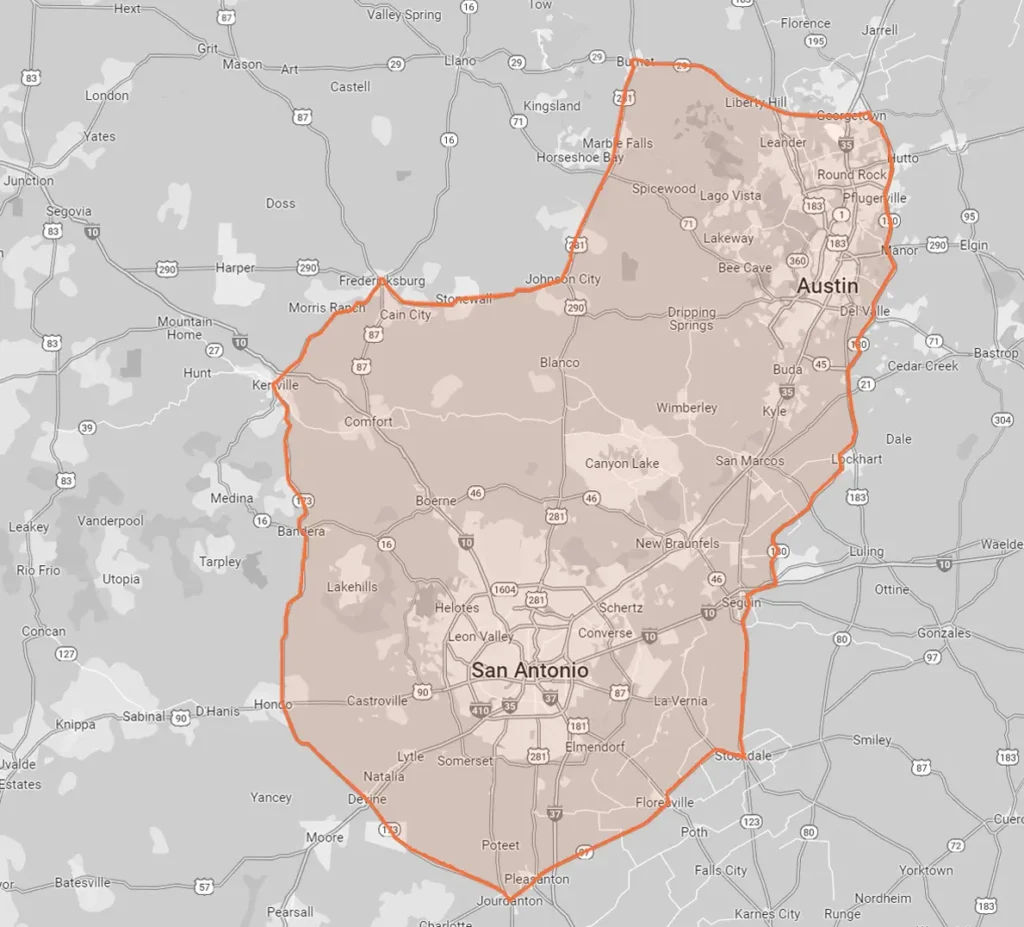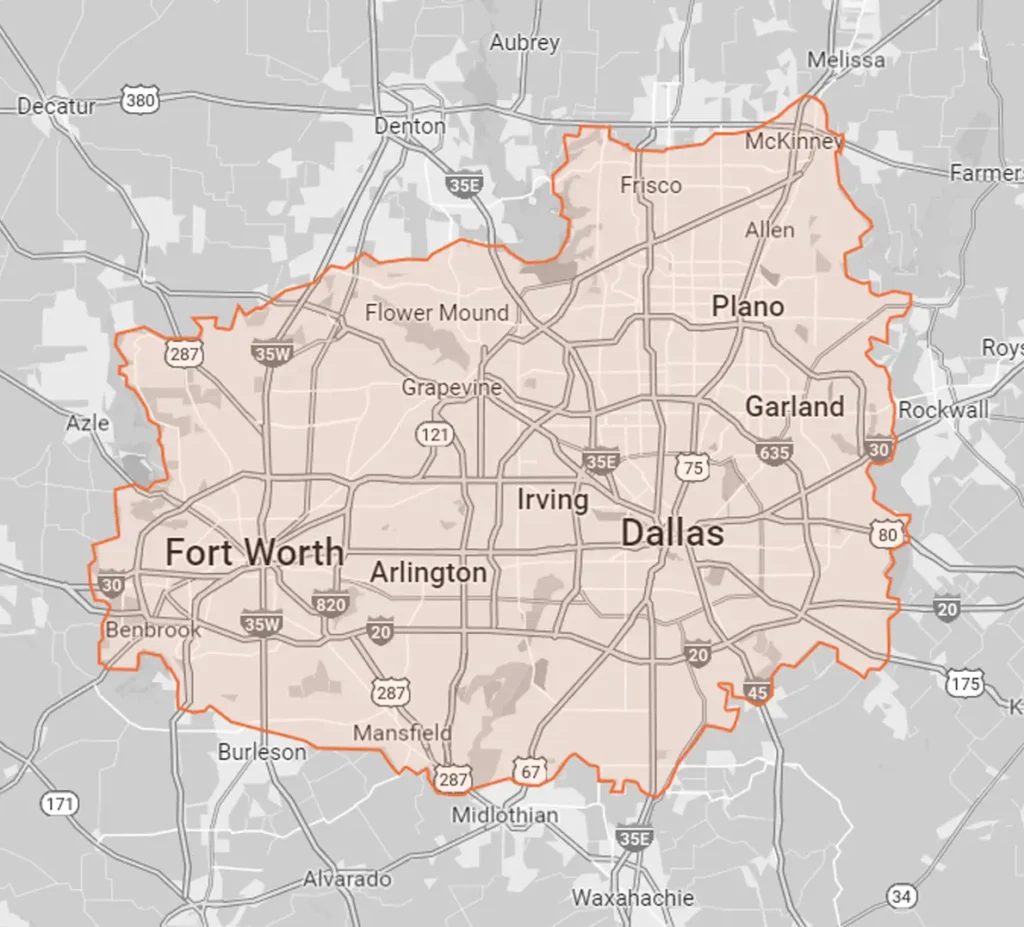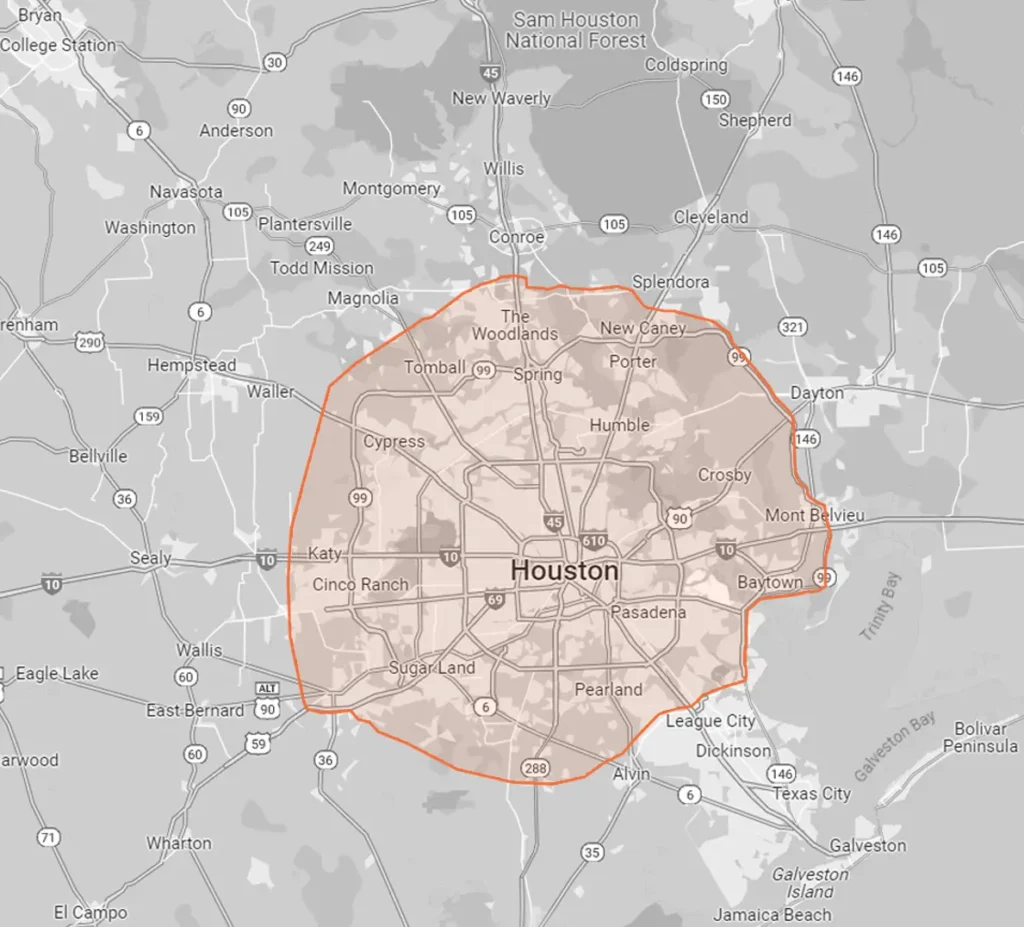Complete Air Conditioner Buyers Guide 2024
Air Conditioner Buyers Guide
One of the most significant purchasing decisions that all homeowners will face at some point is the purchase of a new air conditioner. AC systems can be costly, and you want to ensure you get it right the first time.
There is not much information out there to help homeowners navigate this process. Many AC companies will take advantage of this by pushing what they have in stock or, like most, price gouge.
We created this buyer’s guide to help homeowners make the most informed decision possible when purchasing a new AC system.
Single-Stage vs Two-Stage vs Variable-Speed
The quality of an HVAC system differs significantly when it comes to stages.
- Single-Stage – Little control and possibly hot and cold spots
- Two-Stage – Reduce hot and cold spots with humidity control
- Variable-Speed – Provides the highest level of comfort and energy savings
Single Stage
A single-stage air conditioner is a basic on-off HVAC system with pros and cons.
- Pros: A one-speed system works great for homes less than 1300 sqft where there is no significant benefit to going with a multi-stage system. These units are also great for rental properties because it’s the most budget-friendly system.
- Cons: Because it is a simple on-off system, it can create hot and cold spots throughout your home due to the fast cycle time. The quick cycle time can also lead to humidity issues making your home feel clammy inside.
Two Stage
A two-stage HVAC is one of the most popular AC systems we sell to homeowners. It strikes a happy medium between comfort and pricing. It does a lot more than a single-stage system but costs less than a variable-speed system.
- Pros: A two-speed system runs longer than a single-speed system, helping reduce hot and cold spots in your home. The longer run time also helps to lower humidity levels which is excellent for comfort.
- Cons: These systems cost about $2,000 more than a single-speed system.
Variable Speed
Variable-speed HVAC systems are the Cadillac of air conditioners. They are the best-performing HVAC systems on the market, but like everything high-end, they come at a high price.
- Pros: These systems run all the time, which gives you complete temperate control in your home down to one degree. The extra circulation is ideal for large homes that need extra circulation to prevent the hot and cold stops. It also has great humidity control that will help protect valuable furniture and art. Along with the constant filtration in your home year-round also helps with air quality.
- Cons: Anything high-end comes at a cost. A variable-speed system will be about double the price of a single-speed system. Just like a Cadillac, repairs can get pricy and more frequent than with other systems.
Types of AC Systems
Three main types of central air conditioning and heating system are used in the US. Gas systems, which use gas to heat the home, cost the most to replace, primarily due to safety code compliance that must be followed during installation. Heat pump HVAC systems use the outdoor AC unit to both cool and heat the home. Because this makes them the most energy-efficient system on the market, they have become the most popular HVAC system. Straight electric AC systems are the least energy-efficient but also the cheapest. These systems are mainly installed in rental properties and apartments.
Do You Have A Gas System?
There are a couple of things you can look for to help identify if you have a gas HVAC system. The first is, ” Does your indoor unit have a flue pipe?” If so, you have a gas furnace. The second is, “Do you have a monthly gas bill?” If you do, there is a very good chance you have a gas HVAC system.
Do You Have A Heat Pump?
Heat pumps are continuing to grow in popularity, but it can be a little tricky to know whether or not you have one. The first thing you can do to check if you have a heat pump is to turn your thermostat to heat and raise the temperature until the heater comes on. From there, you can check your outdoor unit. If the outdoor unit is running, then you have a heat pump. However, if your outdoor unit is not working, this might not work. In that scenario, you can check your thermostat and see if there is an emergency heat setting on it. If there is one, there is a good chance you have a heat pump.
Do You Have A Straight Cool With Electric Heat?
Straight-cool systems with electric heat are among the least common types of HVAC systems in residential homes because they are the least energy-efficient. However, the easiest way to find out if that is what you have is to rule out the other two types of systems. If you have no monthly gas bill that means you do not have a gas furnace. If your outdoor AC unit does not turn on when you are heating your home, then you do not have a heat pump. Then the rule of thumb is that you most likely have a straight cool system with electric heat.
Best Air Conditioner Brands
Buying a new AC system is a big deal. No one wants to purchase an HVAC system that can’t stand the test of time. Choosing the brand alone can be confusing since there are 28 major HVAC brands in America. However, only six manufacturers build all these brands, which simplifies things. For example Carrier has nine different brands under their umbrella. Carrier and Bryant are their premier lines, while the 6 ICP brands are in their mid-tier lines, and Payne is their builder’s grade. So if you are looking for the best brands in their product lines, you’re going to want to go with a Carrier or Bryant. However, if you are looking for the cheapest, you may want to consider a Payne. If you are interested in learning about each manufacturer and how they all stack up against each other, you might want to check out our Best Brands blog post by clicking here.
All Brands Explained
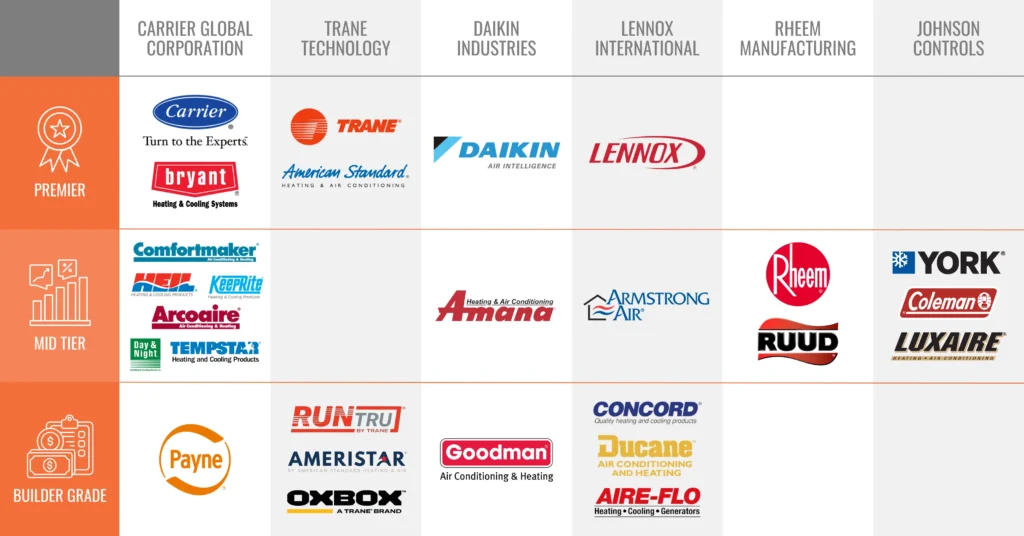
Carrier Our Primary Brand
Goodman Our Budget Brand
Ductwork & Insulation
Just like your AC system, ductwork doesn’t last forever. Ductwork can get dirty inside or sometimes moldy. After a certain age, it will start to fall apart and could lead to loss of airflow and efficiency. In these cases, you might want to replace your ductwork to keep your HVAC system performing properly year around.
It’s also common for your attic insulation to wear down over time to the point it’s no longer doing its job, leading to high electric bills. Blown-in insulation is one of those quick and inexpensive solutions that can help keep your home as energy efficient as possible, along with helping with hot and cold spots in your home.
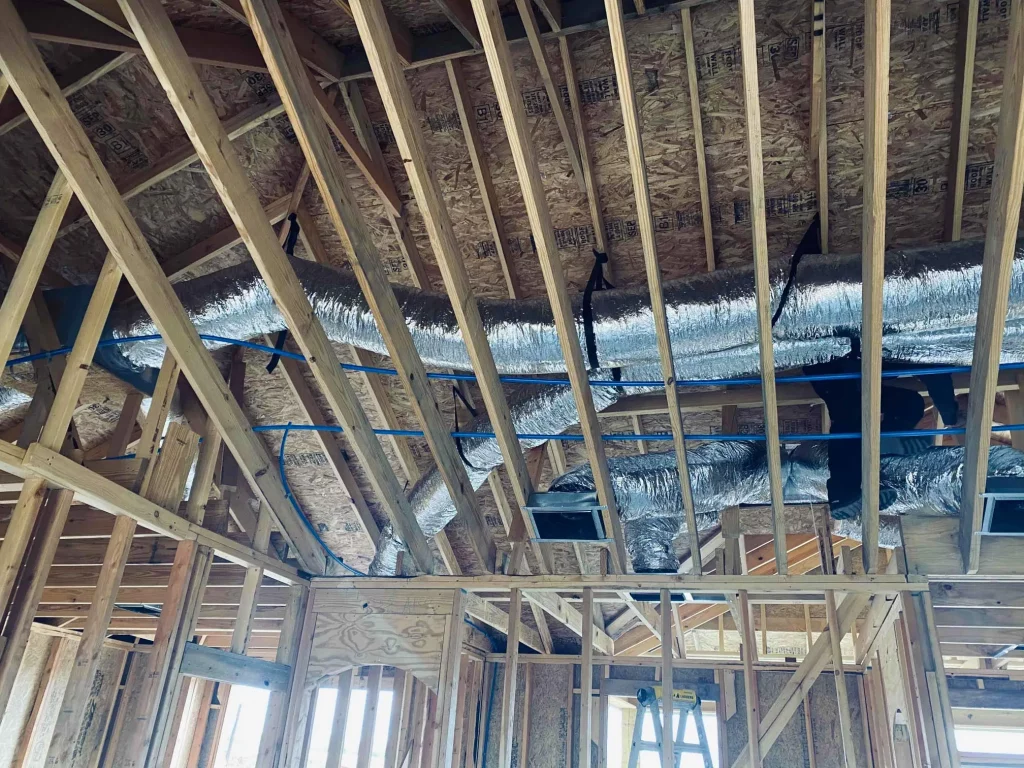
Ductwork
Blown In Insulation
Over time the insulation in your attic can slowly deteriorate where it no longer insulates your home properly. This can lead to an increase in your utility bill and potentially hot and cold spots throughout your home. A simple and inexpensive solution to this problem is to blow in new insulation, increasing your home’s efficiency and lowering your electric bill.
How Much Does Ductwork & Insulation Cost?
Ductwork and insulation are some of the best additions to an air conditioning system to keep your home running as efficiently as possible. Consider potential ductwork or blown-in insulation when planning to replace your AC system.
- Replace Duct Run – $525.00 ea.
- New Duct Run – $725.00 ea.
- New Duct Board Plenum – $477.00 ea.
- New Metal Plenum – $750.00 ea.
- R19 Blown in Insulation – $1.00 sqft.
- R30 Blown in Insulation – $1.50 sqft.
Air Conditioner Sizing
Correctly sizing an air conditioner is critical for many different reasons. Too small an AC won’t be able to keep up with the demand, eventually running itself to death. Too large a system could lead to short cycling, creating hot and cold spots in your home. The chart above is a rule of thumb and can vary based on the age, size, and location of your home. Use it for budgeting, but keep in mind that a heat load will have to be run to ensure that the system is sized right.
Tonnage Per Home Type
Please note these are rule-of-thumb estimates based on our service area in Texas.
- Pier Beam Homes – 350 SQFT Per Ton
- Built in 1950 to 1979 – 450 SQFT Per Ton
- Built in 1980 to 1999 – 500 SQFT Per Ton
- Built in 2000 + Homes – 550 SQFT Per Ton
- Spray Foam Insulated – 750 SQFT Per Ton
SQFT to Tonnage
- 1.5 Tons – 600 to 900 FT
- 2 Tons – 900 to 1200 FT
- 2.5 Tons – 1200 to 1500 FT
- 3 Tons – 1500 to 1800 FT
- 3.5 Tons – 1800 to 2100 FT
- 4 Tons – 2100 to 2400 FT
- 5 Tons – 2400 to 3000 FT
Seer Ratings and Savings
Choosing the right SEER rating for a homeowner can be a frustrating process. There is a lot of confusing information out there, which makes it challenging to know what you should pick. Some HVAC contractors will tell you you need to go up in SEER rating because it will pay for the entire AC replacement. As you can see below, that is not the case. The higher the SEER doesn’t mean that it will pay for itself. For example, the cost of a 25 SEER HVAC system can run as high as $20,000, but a 16 SEER system can be around $8,000. So, if you are weighing out the option between cost vs. saving, higher SEER doesn’t always mean better.
AVERAGE SAVINGS OVER 10 YEARS
14.3 SEER – $1,585
15.2 SEER – $1,879
16 SEER – $2,256
18 SEER – $2,884
20 SEER – $3,386
24 SEER – $4,139
* Based on a 3-ton HVAC system using Seer2
14 SEER
Here are a few scenarios where a homeowner won’t benefit much from purchasing a high-SEER HVAC system:
- If you are planning on moving in the next few years, the savings gained in that short amount of time won’t be enough to make the cost of a high-SEER system worth it. There is little benefit to focusing on efficiency since it won’t increase the value of your home.
- If replacing an HVAC system in a rental property, it’s usually not worth spending the extra money since you won’t be paying the electric bill and reaping the savings. And not all tenants will properly take care of the system, shortening its life expectancy.
15 - 17 SEER
Most homeowners purchase 15-17 SEER air conditioners for various reasons.
- It’s not the cheapest or most expensive HVAC system. Most of the time, the utility savings allow the unit to pay for itself, so you will see a difference in your electric bill compared to what you would see with a 14 SEER.
- Most utility companies will offer a rebate for AC units over 15 SEER, around $100 to $120 per ton for an HVAC system, which is free money to the homeowner, and most of the time will pay the difference for upgrading from a 14 SEER system to a 15 SEER system.
18+ SEER
Higher SEER-rated AC systems are sold less often than other units, and that is largely due to their cost. However, there are a few good reasons why you might want a high SEER-rated HVAC system.
- Most high SEER-rated HVACs are variable speed systems that deliver the highest level of comfort for your home. So, for most homeowners who purchase a high SEER system, it is largely because they are looking for the highest comfort for their home.
- If you plan to go solar, it might be worth looking into this option. An 18+ SEER HVAC system will help to reduce the number of solar panels and batteries needed to power your home.
- The electric bill becomes a headache in large houses with more than one AC unit. High-SEER-rated AC systems help keep your electric bills as low as possible.
New Air Conditioner System Cost
Many homeowners have an idea when their AC system is on the fritz and will need to be replaced shortly. One of the first steps is to set a budget. So you start looking around online to help establish a budget, like looking for a new car. Come to find out; no one publishes any pricing. So you are left with calling an AC contractor for pricing. Then they send someone to your home to look at your equipment and give you a price. About a half hour of the technician being at your house, you realize you are dealing with a vacuum cleaner salesperson.
If you are reading this, you have most likely experienced this situation. You can’t find any pricing online because contractors are trying to put someone in your home to charge as much as possible.
The HVAC industry lacks transparency, so we openly publish our pricing and make buyer’s guides like this one. The worst-case scenario for us is you can keep your AC guy honest; the best-case is you’ll give us a chance.
To check out our detailed pricelist, click here.
Cost By Tonnage
Please note that the cost variation comes from the difference between gas, heat pump, and straight electric
- 2 Ton – $7,134 to 7,850
- 2.5 Ton – $7,539 to $7,991
- 3 Ton – $7,709 to $8,377
- 3.5 Ton – $8,473 to $8,885
- 4 Ton – $8,979 to $9,414
- 5 Ton – $9,708 to $9,906
Cost By Seer
The pricing below is based on a 3-ton gas HVAC system
- Carrier Comfort 15 SEER Single Stage – $8,377
- Carrier Crossover 15.5 SEER Variable Speed – $10,503
- Carrier Performance 16 SEER Two Stage – $10,955
- Carrier Infinity 18 SEER Five Stage– $14,153
- Carrier Greenspeed 22 SEER Variable Speed – $15,999
Controls & Air Quality
If you want better control over your AC system or to improve air quality, consider adding certain features that don’t come standard with an AC replacement, like a wifi programable thermostat or better air filtration for your home. These add-ons can make all the difference to how your HVAC system performs. They allow you to remote control your AC system from work or vacation and better deal with allergies and pet odors.
Additional HVAC Options
There are a few add-ons that aren’t standard that you can have included when you replace your AC system allowing you to control your AC from anywhere and to purify the air in your home better.
- Controls
- Ecobee 3 Lite Pro – $399
- Honeywell 8000 – $425
- UV Lights
- Reme Halo LED – $1,190
- BLU-QR UV-C – $398
- Filtration
- Honeywell Filter Base – $475
Controls
An upgraded thermostat is one of the best additions to an HVAC replacement package. Programmable thermostats can be scheduled to raise or lower the temperature throughout the week automatically. A wifi compatible thermostat gives you control anywhere in the world, even going as far as alerting you when it’s time to change the filter or if there is something wrong with the system.
Air Quality
We experience a lot of pollen and mold throughout the year in Texas. In peak season, it feels like you can go nowhere to get relief. If you struggle with pollen, mold, or asthma, there is a solution that can significantly benefit you. A Midea filter with a Reme Halo UV light can reduce odors and the spread of bacteria and viruses along with toxins and pollutants. This combo can dramatically improve the air quality in a home.
Utility Rebates
The process of getting a rebate from a utility company is relatively straightforward.
- To start, you want to ensure you get the suitable SEER rating to qualify for a rebate. To play it safe, I recommend selecting a 16-SEER AC system. Some utility companies allow a 15-SEER AC system to qualify; however, some 15-SEER equipment will not qualify because they will also look at the EER rating and if it’s not high enough you can’t qualify. I have seen this happen before with 4 and 5-ton systems. So, it’s easiest to get a 16-seer system to ensure this doesn’t happen.
- The next step after the installation is the application. We fill out the application for our customers to ensure all the paperwork is completed correctly.
- Often the utility company will require the application to be submitted from the homeowner. So we will send the application to our customer, and from there, they will send it to the utility company.
- The utility company can take anywhere from one to four months to process your rebate. So, don’t expect it right away.
- The utility company sends the rebate as a credit to your account. So don’t expect a check; it’s more like you will not have an electric bill for a month or two.
Energy Efficiency Rebates
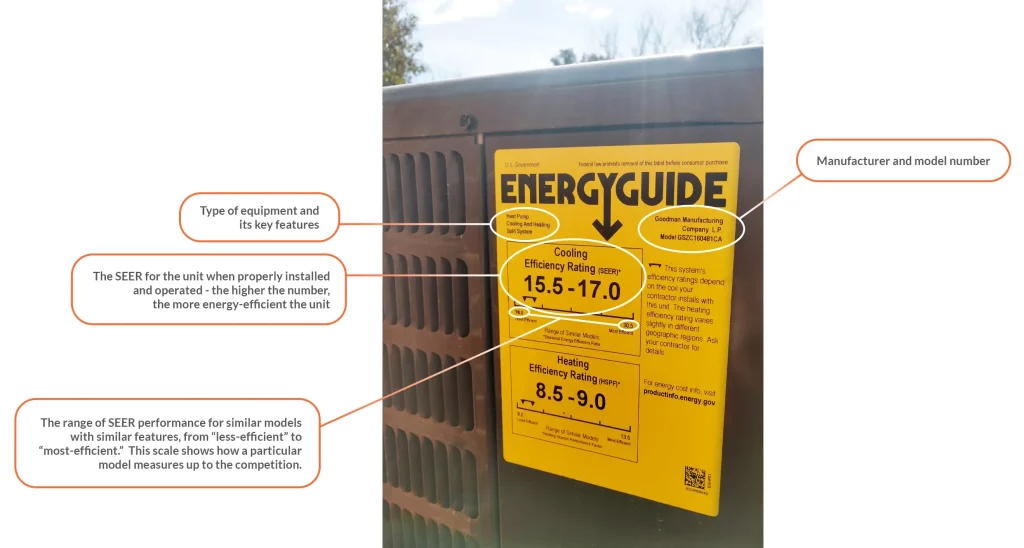
HVAC Warranties
There are two types of warranties when it comes to air conditioning, the first is the parts warranty, and the second is the labor warranty. Parts warranties need to be handled correctly, or the homeowner might lose out on a 10-year warranty.
- Parts Warranty – 5 to 10 Years
- Labor Warranty – 2 to 10 Years
Parts Warranty
All new outdoor AC units and indoor furnaces come with a 5-year factory warranty. After the installation, the equipment can be registered with the manufacturer under the homeowner’s name and address to gain an additional five years to the parts warranty. So, in the end, you should be able to get a 10 years parts warranty.
- We handle the equipment registration for our customers after the system is installed. That makes it easier for our customers because it will help ensure everything was done correctly.
Labor Warranty
Why is there a 9-year variation when it comes to labor warranties? A standard labor warranty is provided by the contractor, typically for the first year. An extended labor warranty can be purchased for an additional cost and works like insurance. A 3rd party company will buy a labor policy that helps guarantee that the homeowner is protected.
- 2 -year warranty – Included
- 5 -year warranty – $1,100
- 10-year warranty – $1,970
Air Conditioner Financing
Let’s face it, purchasing a new AC system can be costly and sometimes the need for one comes unexpectedly. Air conditioner financing can help, and getting approved can be a swift process. It only takes a few minutes to get preapproved, which helps if you need a quick solution. If you want to finance your HVAC system, click here to apply.
Finance Process
The process to finance your air conditioner is relatively fast and straightforward. We use a 3rd party finance company that handles all finance options for us, which expedites the process versus working with a bank that could take days or even a week to get something lined up.
- Fill out an application (you can find it in the finance tab) and get preapproved in minutes.
- Additional information will be requested, like proof of income and ownership of your home.
- Sign the loan document you receive.
- We move forward with installing the new AC system. Upon completion, you will confirm with the finance company that the replacement process has been finished, and that’s everything.
Finance Rates
A bank or credit union will always win if you are looking for the lowest finance rate. If you come across a contractor offering 0% interest, they are paying a dealer fee, which means they have to raise their prices a couple of thousand dollars to pay off all the interest upfront. So you are going to pay a high-interest rate one way or another. We don’t offer any programs with dealer fees because it’s important to us to be upfront and transparent.
- $7,500 @ 10.9% @ 15yrs = $86.16
- $10,000 @ 10.9% @ 15yrs = $114.87
- $12,500 @ 10.9% @ 15yrs = $143.59
Atlas AC Repair Service Area
Atlas AC Repair serves San Antonio, Austin, DFW, Houston, and the surrounding areas.


